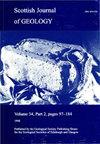石英-碳酸盐混合海洋体系中碳酸钙沉积的时空变化:埃迪卡拉纪Deeside石灰岩组,苏格兰Aboyne
IF 1.3
4区 地球科学
Q4 GEOLOGY
引用次数: 0
摘要
Deeside石灰岩组(DLF)出露于阿伯丁郡西部,包括埃迪卡拉纪独特的上达尔弧度混合硅碎屑-碳酸盐岩系统的东部边缘,该系统可能向西南方向关联了400多年 距离爱尔兰的多尼戈尔郡公里。重建的地层柱表明有三个广泛的垂直序列(S1–S3),每个序列都包括碳酸钙相对于石英的总体向上成比例的增加,局部被金属嵌岩覆盖(L1–L3)。对这种向上变化的一个简单解释是,在相同的水动力过程下,两种异岩屑组分的物理响应不同,较重的石英颗粒优先富集推移质,较细的碳酸盐泥组分优先富集悬浮质。仅在油田区域的中部/东部观察到三个金属碎屑岩层段,表明存在横向相变化。DLF中钙质-硅质碎屑层规模的成分混合占主导地位,这表明Dalradian陆架上的沉积包括硅质碎屑和碳酸盐组分的同期混合,然后在向下斜坡输送到深水的过程中再次混合,其间穿插着点源硅质碎屑输入的脉冲。本文章由计算机程序翻译,如有差异,请以英文原文为准。
Temporal and spatial variations in calcium carbonate deposition in a mixed siliciclastic–carbonate deep marine system: the Ediacaran Deeside Limestone Formation, Aboyne, Scotland
The Deeside Limestone Formation (DLF), outcropping in western Aberdeenshire, comprises the eastern margin of a distinctive Upper Dalradian mixed siliciclastic–carbonate system of Ediacaran age which may be correlated southwestwards for more than 400 km to County Donegal in Ireland. A reconstructed stratigraphic column suggests three broad vertical sequences (S1–S3), each comprising a general upward proportionate increase in calcium carbonate with respect to quartz, locally capped by metalimestones (L1–L3). A simple explanation for this upward change lies in the differing physical response of the two heterolithic components under the same hydrodynamic process, with the heavier quartz grains preferentially enriching the bedload and the finer carbonate mud fraction, the suspended load. The three metalimestone intervals are observed only in central/eastern parts of the field area, suggesting a lateral facies variation. The predominance of calcareous–siliciclastic bed-scale compositional mixing within the DLF suggests sedimentation on the Dalradian shelf comprised contemporaneous mixing of the siliciclastic and carbonate fractions prior to subsequent re-mixing during transportation downslope into the deep water, punctuated by pulses of point-sourced siliciclastic input.
求助全文
通过发布文献求助,成功后即可免费获取论文全文。
去求助
来源期刊

Scottish Journal of Geology
地学-地质学
CiteScore
1.70
自引率
0.00%
发文量
10
审稿时长
>12 weeks
期刊介绍:
Although published only since 1965, the Scottish Journal of Geology has a long pedigree. It is the joint publication of the Geological Society of Glasgow and the Edinburgh Geological Society, which prior to 1965 published separate Transactions: from 1860 in the case of Glasgow and 1863 for Edinburgh.
Traditionally, the Journal has acted as the focus for papers on all aspects of Scottish geology and its contiguous areas, including the surrounding seas. The publication policy has always been outward looking, with the Editors encouraging review papers and papers on broader aspects of the Earth sciences that cannot be discussed solely in terms of Scottish geology.
The diverse geology of Scotland continues to provide an important natural laboratory for the study of earth sciences; many seminal studies in geology have been carried out on Scottish rocks, and over the years the results of much of this work had been published in the Journal and its predecessors.
The Journal fully deserves its high reputation worldwide and intends to maintain its status in the front rank of publications in the Earth sciences.
 求助内容:
求助内容: 应助结果提醒方式:
应助结果提醒方式:


